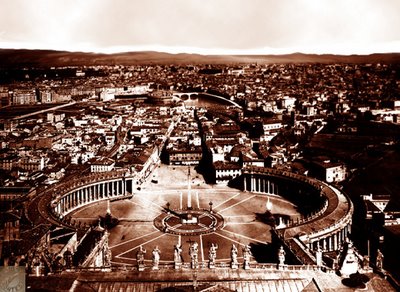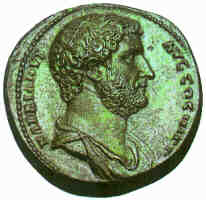

 The first picture was taken in 1899 from the top of the Saint Peter’s Basilica. The “spina di borgo”, characteristic zone of the medieval and renaissance Rome, has been demolished in order to leave place to the Conciliation street inaugurated in 1937 (Conciliation between Italian kingdom and the Pope in 1929, you have to remember that Rome was ruled bay Popes till 1870 when the “bersaglieri” soldiers of Italian Kingdom entered the city and the Pope retired in Vatican, The popes till 1870 used to reside in “Quirinale” the big palace that staring from 1870 became the palace of the Kings of Italy, Savoia family). On the background the works of construction of the Palace of Justice are still not begun (building work started in 1889 and finished in 1910, architect Guglielmo Calderini).
The first picture was taken in 1899 from the top of the Saint Peter’s Basilica. The “spina di borgo”, characteristic zone of the medieval and renaissance Rome, has been demolished in order to leave place to the Conciliation street inaugurated in 1937 (Conciliation between Italian kingdom and the Pope in 1929, you have to remember that Rome was ruled bay Popes till 1870 when the “bersaglieri” soldiers of Italian Kingdom entered the city and the Pope retired in Vatican, The popes till 1870 used to reside in “Quirinale” the big palace that staring from 1870 became the palace of the Kings of Italy, Savoia family). On the background the works of construction of the Palace of Justice are still not begun (building work started in 1889 and finished in 1910, architect Guglielmo Calderini).The second picture was taken in 1938 from Sant’Angelo Castle. You can see the Basilica of Saint Peter and Conciliation street not still completed. To the age of the photo the “spina di borgo” had been demolished.
The third picture shows Conciliation Street that was opened in 1937. There are aligned on the way “Santa Maria in Transpontina” very ancient church, rebuilt in 1566 (renaissance facade of G.S. Peruzzi, son of Baldassarre, finished in the 1587 from Mascherino); the palace Torlonia, already Giraud, reproduction in reduced scale of the papal “cancelleria”; the palace of the Convertendi, erected in the second half of the XVI century, demolished, moved and here reconstructed in 1937. In front of this palace there’s the palace of the Penitenzieri, attributed to Pontelli (1481), but almost rebuilt (in the inside, frescoes attributed to the Pinturicchio). The demolition of the “spina di borgo” has destroyed the effect produced by the opening unexpected of Saint Peter Square beyond the buildings of the “spina”. Saint Peter square, masterwork of architecture of Bernini (1656-1667), is an immense ellipses 240 meters width. The 284 colossal columns and the 88 pillars altogether form 3 covered galleries 17 meters wide, crowned from 140 statues of saints and from the great coats of arms of Alexander VII. In bottom to the right porch there is the bronze door of the Vatican palace. To the center of the public square between the two beautiful fountains, there’s an obelisk 25,50 meters high, based on the back of four bronze lions, placed on the high pedestal. This obelisk in the Middle Age was called “aguglia”, and people believed that on the top, in a gold urn, the ashes of Cesar were placed.


No comments:
Post a Comment